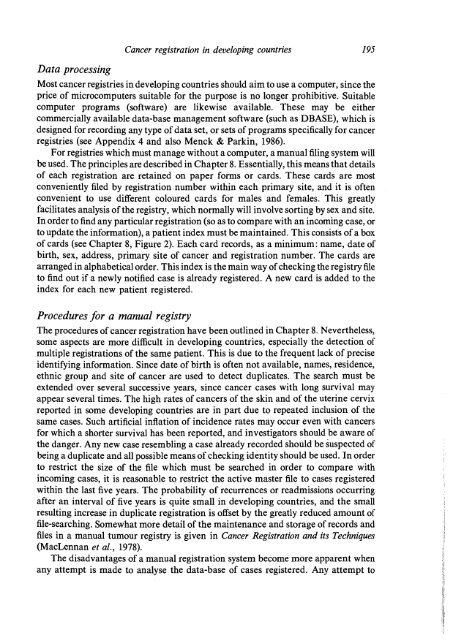Cancer Registration: Principles and Methods - IARC
Cancer Registration: Principles and Methods - IARC
Cancer Registration: Principles and Methods - IARC
You also want an ePaper? Increase the reach of your titles
YUMPU automatically turns print PDFs into web optimized ePapers that Google loves.
<strong>Cancer</strong> registration in developing countries 195<br />
Data processing<br />
Most cancer registries in developing countries should aim to use a computer, since the<br />
price of microcomputers suitable for the purpose is no longer prohibitive. Suitable<br />
computer programs (software) are likewise available. These may be either<br />
commercially available data-base management software (such as DBASE), which is<br />
designed for recording any type of data set, or sets of programs specifically for cancer<br />
registries (see Appendix 4 <strong>and</strong> also Menck & Parkin, 1986).<br />
For registries which must manage without a computer, a manual filing system will<br />
be used. The principles are described in Chapter 8. Essentially, this means that details<br />
of each registration are retained on paper forms or cards. These cards are most<br />
conveniently filed by registration number within each primary site, <strong>and</strong> it is often<br />
convenient to use different coloured cards for males <strong>and</strong> females. This greatly<br />
facilitates analysis of the registry, which normally will involve sorting by sex <strong>and</strong> site.<br />
In order to find any particular registration (so as to compare with an incoming case, or<br />
to update the information), a patient index must be maintained. This consists of a box<br />
of cards (see Chapter 8, Figure 2). Each card records, as a minimum: name, date of<br />
birth, sex, address, primary site of cancer <strong>and</strong> registration number. The cards are<br />
arranged in alphabetical order. This index is the main way of checking the registry file<br />
to find out if a newly notified case is already registered. A new card is added to the<br />
index for each new patient registered.<br />
Procedures for a manual registry<br />
The procedures of cancer registration have been outlined in Chapter 8. Nevertheless,<br />
some aspects are more difficult in developing countries, especially the detection of<br />
multiple registrations of the same patient. This is due to the frequent lack of precise<br />
identifying information. Since date of birth is often not available, names, residence,<br />
ethnic group <strong>and</strong> site of cancer are used to detect duplicates. The search must be<br />
extended over several successive years, since cancer cases with long survival may<br />
appear several times. The high rates of cancers of the skin <strong>and</strong> of the uterine cervix<br />
reported in some developing countries are in part due to repeated inclusion of the<br />
same cases. Such artificial inflation of incidence rates may occur even with cancers<br />
for which a shorter survival has been reported, <strong>and</strong> investigators should be aware of<br />
the danger. Any new case resembling a case already recorded should be suspected of<br />
being a duplicate <strong>and</strong> all possible means of checking identity should be used. In order<br />
to restrict the size of the file which must be searched in order to compare with<br />
incoming cases, it is reasonable to restrict the active master file to cases registered<br />
within the last five years. The probability of recurrences or readmissions occurring<br />
after an interval of five years is quite small in developing countries, <strong>and</strong> the small<br />
resulting increase in duplicate registration is offset by the greatly reduced amount of<br />
file-searching. Somewhat more detail of the maintenance <strong>and</strong> storage of records <strong>and</strong><br />
files in a manual tumour registry is given in <strong>Cancer</strong> <strong>Registration</strong> <strong>and</strong> its Techniques<br />
(MacLennan et al., 1978).<br />
The disadvantages of a manual registration system become more apparent when<br />
any attempt is made to analyse the data-base of cases registered. Any attempt to
















